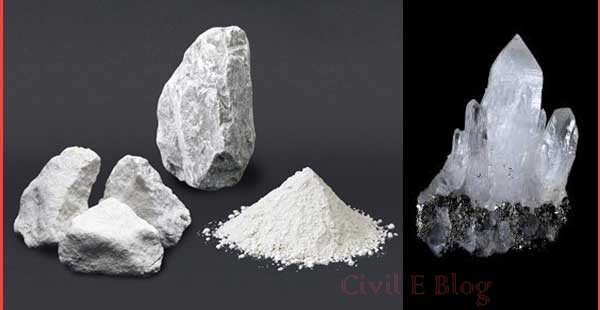
The ordinary cement contains two basic ingredients, namely, argillaceous and calcareous. In argillaceous materials, the clay predominates and in calcereous materials, the calcium carbonate predominates. A typical chemical analysis of a good ordinary cement along with the desired range is as follows:
| Ingredient | Composition (Percent) |
Range (Percent) |
| Lime (CaO) | 62 | 62 to 67 |
| Silica (SiO2) | 22 | 17 to 25 |
| Alumina (Al2O3) | 5 | 3 to 8 |
| Calcium Sulphate (CaSO4) | 4 | 3 to 4 |
| Iron oxide (Fe2O3) | 3 | 3 to 4 |
| Magnesia (MgO) | 2 | 0.1 to 3 |
| Sulphur (S) | 1 | 1 to 3 |
| Alkalies | 1 | 0.2 to 1 |
Functions of cement ingredients
The ingredients of ordinary cement, as mentioned above, perform the following functions:
Lime (CaO): This is the important ingredient of cement and its proportion is to be carefully maintained. The lime in excess makes the cement unsound and causes the cement to expand and disintegrate. On the other hand, if lime is in deficiency, the strength of cement is decreased and it causes cement to set quickly.
Silica (SiO2): This is also an important ingredient of cement and it gives or imparts strength to the cement due to the formation of dicalcium and tricalcium silicates. If silica is present in excess quantity, the strength of cement increases but at the same time, its setting time is prolonged.
Alumina (Al2O3): This ingredient imparts quick setting property to the cement. It acts as a flux and it lowers the clinkering temperature. However, the high temperature is essential for the formation of a suitable type of cement and hence the alumina should not be present in excess amount as it weakens the cement.
Calcium Sulphate (CaSO4): This ingredient is in the form of gypsum and its function is to increase the initial setting time of cement.
Iron oxide (Fe2O3): This ingredient imparts color, hardness and strength to the cement.
Magnesia (MgO): This ingredient, if present in small amount imparts hardness and color to the cement. A high content of magnesia makes the cement unsound.
Sulphur (S): A very small amount of sulphur is useful in making sound cement. If it is in excess, it causes cement to become unsound.
Alkalies: The most of the alkalies present in raw materials are carried away by the flue gases during heating and the cement contains only a small amount of alkalies. If they are in excess, the cause a number of troubles such as alkali-aggregate reaction, efflorescence and staining when used in concrete, brickwork or masonry mortar.

